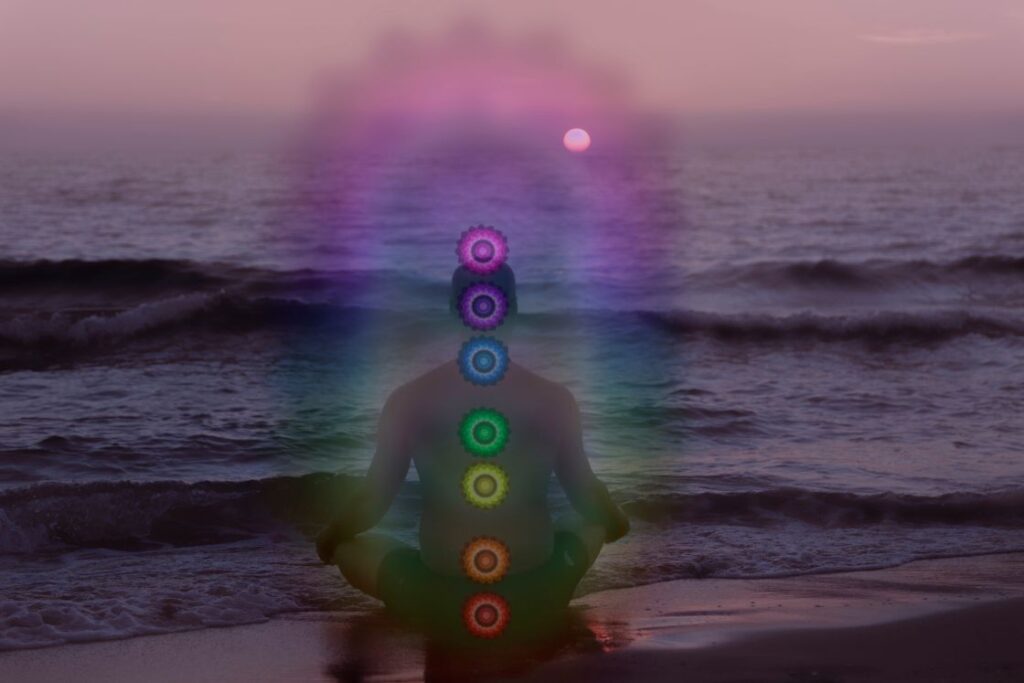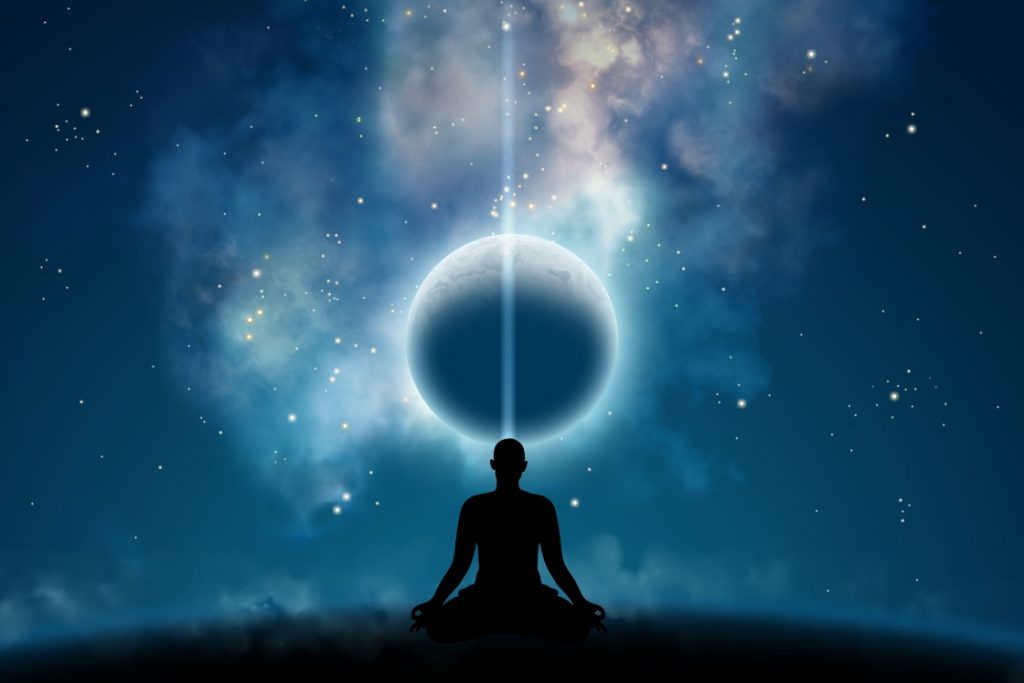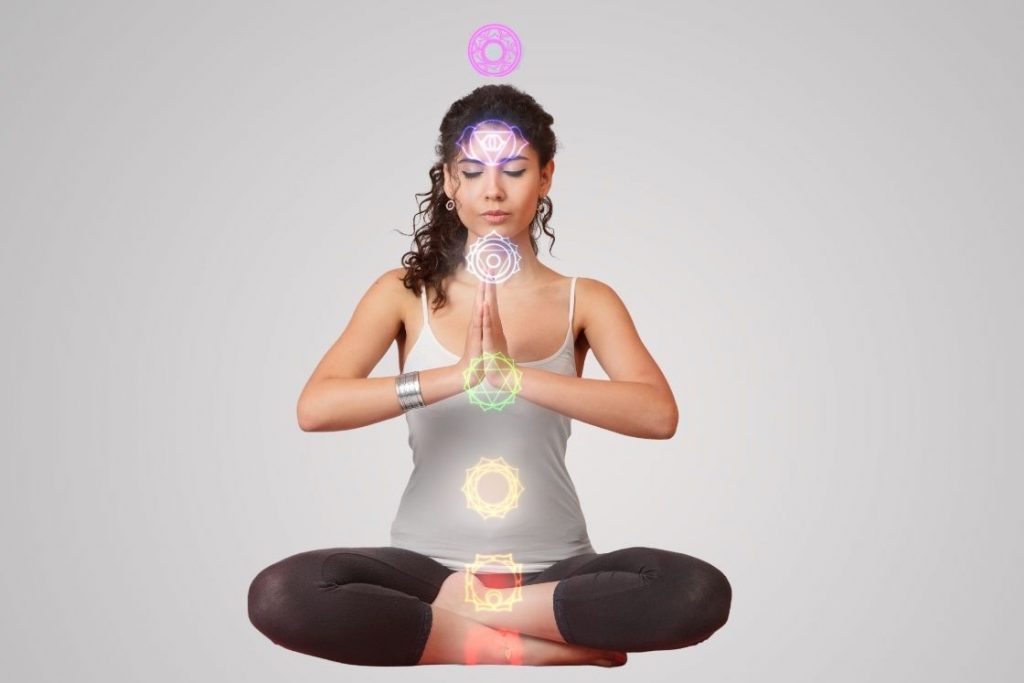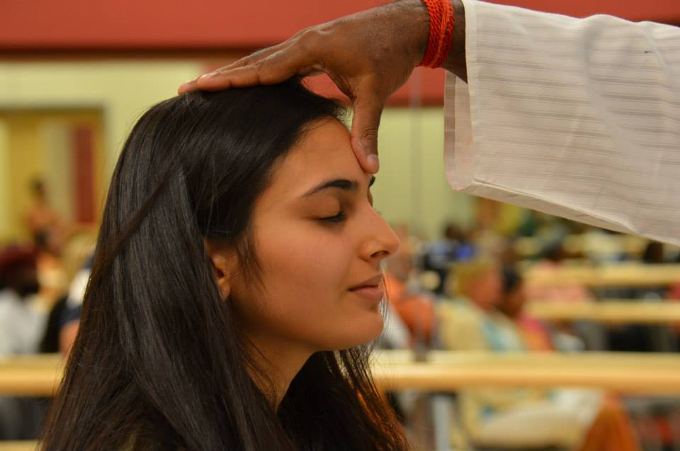
Kundalini awakening is often described in yogic traditions as a shift in inner energy that brings clarity, awareness, and a stronger sense of connection. Some consider it a form of enlightenment where energy rises from the base of the spine and activates higher levels of consciousness.
Interest in Kundalini practices has grown in recent years, especially among those exploring spiritual growth and self-awareness. But while the process may sound appealing, it also involves challenges that require patience, preparation, and care.
In this article, we’ll share practical steps to support the awakening process, explain key techniques used in yoga and meditation, and outline important safety tips to help you approach the practice with confidence.
Benefits of kundalini awakening
At the base of the spine lies Kundalini Shakti, often symbolised as a coiled serpent. This energy represents the dormant inner potential within each individual. When awakened, it’s believed to unlock higher states of awareness and inner balance.
Many practitioners spend years preparing for this process through practices like kundalini kriyas, breathwork, pranayama, meditation, and mudras. For some, the awakening unfolds gradually through dedicated practice. For others, it can happen suddenly and without warning. In traditional yogic teachings, both paths are considered natural.
Kundalini awakening is believed to influence areas of the brain that are typically less engaged in daily functioning. As this energy moves upward through the chakras and reaches the crown (Sahasrara), many practitioners report feeling more focused, emotionally aware, and deeply present.
Although scientific research on Kundalini awakening is still limited, several commonly reported benefits include:
- Increased self-awareness and focus
- Better emotional regulation and stress management
- Enhanced creativity and intuitive insight
- Improved energy levels and physical well-being
- Greater clarity in thought and decision-making
- A deeper sense of connection to others and to life as a whole
How to awaken kundalini?

Kundalini Shakti, the dormant energy believed to rest at the base of the spine, doesn’t awaken on command. While certain practices can support the process, there is no fixed formula or guaranteed timeline. The awakening unfolds differently for each individual, influenced by personal effort, lifestyle, and past karmic impressions.
Rather than trying to force it, the best approach is one of patience, consistency, and respect for the body’s natural rhythm. Rushing or forcing the process can lead to discomfort, emotional overwhelm, or energetic imbalance.
To awaken Kundalini in a safe and sustainable way, it’s recommended to focus on grounding and steady practices:
- Hatha yoga or Kundalini kriyas to prepare the physical and energetic body
- Pranayama (breath control) to regulate the nervous system and move energy
- Meditation to build awareness and stillness
- Mantra chanting or sound vibrations to activate subtle energy
- Mudras and Bandhas to direct prana through the body
- Regular self-reflection to release mental and emotional blocks
Working with a qualified and experienced teacher is highly encouraged, especially if you are new to energy practices. A mentor can offer guidance, help monitor your progress, and keep you grounded as changes unfold.
Lastly, it’s essential to recognise that the Kundalini awakening process is deeply personal. Some may experience subtle shifts over months or years, while others may feel sudden energetic changes. Neither is better it’s simply your path unfolding in its own way.
Techniques to activate kundalini
The underlying theory of kundalini awakening is based on the idea that the human body contains a subtle energy system that can be activated and harmonized to promote physical, mental, and spiritual well-being. This system is composed of nadis, or energy channels, and chakras, or energy centers, which are believed to correspond to different aspects of human experience.
To prepare for kundalini awakening, you must start with cleansing your body, especially the subtle body. You should start by purifying the Ida and Pingala Nadis (left and right energy channels along subtle spine). This will propel the stimulation of the Sushumna nadi or the central nadi, which is the main conduit of the kundalini serpent. If the Sushumna is not open, kundalini may forced into the ida or pingala nadi and might lead to complications.
When your Sushumna Nadi is cleansed and activated, it further paves the way to activate, stimulate, and open all 7 chakras.
Chakra opening is an important aspect of kundalini awakening as the kundalini shakti might get stuck in the lower chakras and lead to kundalini syndrome.
Once your chakras have been opened, the kundalini energy gets a free passage to unite with the crown chakra or the Sahasrara, which is the ultimate goal of kundalini awakening. To make these possible, a series of pranayama, asanas, kriyas, mudras, and meditation must be applied systematically.
Let us look into some techniques to activate the kundalini.
Become a certified Kundalini yoga teacher—Join our 200-Hour Training
1. Cleansing the nadis through pranayama breathwork

In the first step for kundalini awakening, a practitioner can work on taking control of their breathing through pranayama as the energy channels are cleared and refined by it. As you direct your life force to move up and down the energy channel within, training with the breath and specific pranayama techniques can prompt awakening.
Some of the pranayamas that can help with cleansing the nadis (and so activating kundalini) are:
- Nadi Shodhana and Anulom-Vilom
- Surya Behdi and Chandra Bheda Pranayama
- Kapalbhati
- Breath of Fire
- Kumbhaka (Breath Retention)
The main idea behind practicing pranayama for kundalini awakening is that pranayama regulates prana and apana vayus. Using the bandhas while holding your breath causes the apana in the lower chakras to combine with the prana, generating heat that lifts the Kundalini through the chakras and up the spine.
While doing pranayama, sitting in the right position is also important. You should be seated on the ground with your spine and back straight. A straight posture will enable life force to flow through each of the energy centers, and allow it to deliberately move up and down your spine via your breath.
Also read: 12 science-backed benefits of Pranayama
2. Strengthening the body through kundalini yoga

Kundalini yoga serves as a strengthening exercise before the kundalini awakens, which will enable us to handle its intense energy. It employs the use of numerous asanas, mudras, and bandhas to activate dormant kundalini energy in root chakra.
Certain asanas, such as those that involve deep hip openers and spinal twists, can be particularly effective in helping to awaken the kundalini energy. Here are some yoga poses that are particularly helpful in kundalini activation.
- Malasana (Garland Pose) – a deep hip opener that can help to activate the root chakra and promote grounding and stability.
- Ustrasana (Camel Pose) – a backbend that can help to open the heart chakra and promote feelings of love and compassion.
- Matsyasana (Fish Pose) – a chest opener that can help to activate the throat chakra and promote clear communication and self-expression.
- Urdhva Dhanurasana (Upward-Facing Bow Pose) – a deep backbend that can help to activate the entire spine and promote a sense of openness and expansiveness.
- Adho Mukha Svanasana (Downward-Facing Dog Pose) – a foundational pose that can help to energize the entire body and promote grounding, focus, and clarity.
Kundalini Kriyas on the other hand takes into consideration the movement while chanting and performing certain poses and pranayama. The most fundamental is the Sat Kriya wherein you chant Sat Nam in tandem with your breath and adopt the kali mudra on your hands.
Another kriya known as the “Ego Eradicator” combines movement with the Breath of Fire to open your heart, improve spinal strength and balance the brain hemispheres.
3. Surrender the mind through kundalini meditation

Deep breathing, mudras, and mantras can all be used in conjunction with kundalini meditation to help the sleeping kundalini energy awaken. One’s inner resources can be accessed through kundalini meditation to reach a higher level of consciousness.
It is essential to practice letting go, calming down, and focusing the mind. You can acquire mental clarity, calmness, and an improvement in internal flow by doing this.
Remember to dress comfortably, cover your head, and meditate in a quiet place, away from distraction.
Covering the head is said to shield and increase energy flow. To enhance the experience of lightness, your clothes should always be clean, fresh, and preferably white.
It’s preferable to proceed with a practitioner or a guided meditation if you’re unfamiliar with kundalini meditation because it takes a comprehensive approach.
When practised regularly over an extended length of time, meditation safely and reliably encourages the rise of kundalini. It also unlocks the centers of energy in the astral body.
4. Tune the frequency through mantra chanting

Mantra Japa, which is the daily chanting of a mantra a certain number of times, is a technique that can help activate Kundalini Shakti. It is an integral part of kundalini meditation and kriyas as they are a means to develop focus.
In Kundalini yoga (as it’s practised in some schools of the West), practitioners often use mantras written in the Gurmukhi script, which is traditionally associated with Sikhism. However, it’s important to mention that the origin of it actually lies in Hinduism. It is important to clarify that the use of these mantras in Kundalini yoga does not imply that Kundalini yoga and Sikhism are the same. Instead, it reflects the intermingling of diverse spiritual practices over time, contributing to the richness of the Kundalini yoga tradition.
Below are the most commonly used mantras that can help activating kundalini shakti:
- Bija Mantra – SAT NAM – “Truth is my Identity.”
- Adi Mantra – ONG NAMO GURU DEV NAMO – “I bow to the teacher within”.
- Adi Shakti Mantra – ADI SHAKTI, ADI SHAKTI, ADI SHAKTI, NAMO NAMO. SARAB SHAKTI, SARAB SHAKTI, SARAB SHAKTI, NAMO NAMO. PRITHUM BHAGAWATI, PRITHUM BHAGAWATI, PRITHUM BHAGAWATI, NAMO NAMO. KUNDALINI MATA SHAKTI, MATA SHAKTI, NAMO NAMO – “I bow to the primal power, I bow to the all-encompassing power and energy, I bow to that which God creates, I bow to the creative power of the kundalini, the divine mother power.”
- Siri Gaitri Mantra – RA MA DA SA SA SAY SO HUNG – “Sun, Moon, Earth, Infinity: All that is in infinity, I am Thee.”
The root of all these mantras is said to be the Mul Mantra which is as follows:
EK ONG KAR, SAT NAM, KARTA PURKH, NIRBHAO, NIRVAIR,
AKAL MOORT, AJUNI, SAI BHANG, GUR PRASAD, JAP,
AD SUCH, JUGAD SUCH, HABHE SUCH, NANAK HOSI BHEE SUCH
Translation – “The creator of all is One. Truth is His Name. He does everything, fearless, without anger, undying, unborn, self-realized, realized thru Guru’s Grace, Meditate: He was true in the beginning, true through all the ages, true even now. Nanak shall ever be true.”
You must entirely focus on your breathing and connect with the divine sounds to best receive the wonderful energy of these Mantras.
You can balance your inner and outside vibrations by reciting a mantra. It is simpler for us to reach and activate awakening because of the potency of sound and vibration in our bodies.
These mantras also stimulate the chakras on their individual level especially the throat chakra or Vishuddha.
Also read: Benefits of chanting Gayatri Mantra
5. Move your body to get the energy moving
Your body warms up from freeform dancing, which also releases your mind from the constraints of conceptual thought. The standard dancing moves, on the other hand, won’t help you dance up your Kundalini. Play some soothing instrumental music, then allow your body to move with the energy.
You can move in a way that will help you more deeply connect with your kundalini energy, including spontaneous dancing, chakra dancing while sensing your body’s energy field, and walking on the Earth’s vibrations.
This is also one of the explanations for why dance is sometimes taught as a part of awakening in meditation retreats or classes. Even Osho’s Kundalini meditation has four stages – shake, dance, sit in stillness, and lie down in stillness.
Activate your hips. Be vocal and resonate.
6. Combine the masculine and feminine energy through Tantra
Through mantra and meditation, Shakti is worshipped in the greatest tantric form, integrating Shiva and Shakti inside the seeker. These two forces can combine to create an upsurge and an awakening.
Tantra yoga doesn’t involve sexual activity, but it has a strong focus on pleasure and developing bodily awareness.
Traditional tantra yoga prioritizes inner connection and introspection, with the ultimate objective of self-knowledge and empowerment taking precedence above physical flexibility, strength, and previous knowledge of the postures.
One of the major benefits of tantric yoga is personal empowerment.
Awakening this cosmic energy and causing it to travel via the chakras is the intent of the Tantric form of Kundalini yoga. This energy will then merge with Shiva, the pure mind, which is at the crown of the head.
This route should only be taken by those who have successfully overcome their passions and wants. Therefore, getting advice from a guru is crucial.
7. Instantaneous awakening through shaktipath

One of the most widely used methods for waking the Kundalini quickly is shaktipat. It is regarded as the most straightforward method for assisting the recipient in understanding what awakening truly is.
Through the tantric practice of shaktipat, a person’s guru or master can transmit cosmic energy directly to them as a person (disciple).
Shaktipat is only possible when a disciple is completely devoted to and submissive to their guru.
For the teacher to awaken the disciple, the pupil must be suitably prepared. By touch, sight, or even just a thought, the Guru can transmit energy or power to a disciple. It can be carried out either in the master’s physical presence or remotely.
Even an item given by the Guru to the disciple, a mantra, a word, or perhaps even just by looking at someone might convey it.
A student who acquires Shaktipat will have heavenly insights in a split second and feel bliss without indulging in any spiritual effort.
The guru will be aware of when shaktipat initiation is required, which is a crucial thing to keep in mind in this situation. The process is never forced. Additionally, the initiation of shaktipat is only effective if the guru delivering it has acquired it from a master.
Is kundalini awakening safe?

Kundalini awakening has its own risk and reward because it is a strong force present within us in dormant form. When the right procedures and rules are not followed, it may turn out to be dangerous.
The Kundalini awakening experience can be pretty terrifying if you’re not ready for it. When kundalini is improperly handled or quickly awakens with the wrong approach, a person will undergo a series of unpleasant, negative experiences known as kundalini syndrome.
Kundalini is not hazardous due to the energy or process of awakening; rather, it is dangerous due to the individual’s practice, method and intention.
A harmful kundalini awakening can be addressed on the level of the subtle body as the outcome of a clogged or uncleaned Nadis system.
When Kundalini awakens, it should always ascend through the sushumna nadi, but sometimes it is compelled to enter the ida or the Pingala nadi. It occurs when prana within the nadis is out of balance, meaning your nadis aren’t completely purified yet, and kundalini unintentionally awakens.
People who go through sudden kundalini awakening report experiencing some of the following symptoms:
- Muscle spasms
- A sudden rush of energy throughout the body
- Overly sensitive sense organs
- Pressure in the skull, intense headache
- The ringing of the ears
- Astral, psychic, and out-of-body experiences
- Enhanced awareness, memories of past life, healing powers
Precautions
Kundalini awakening can be a powerful and transformative experience, but it is important to approach the practice with caution and respect. Here are some precautions that practitioners should consider while working on kundalini awakening:
- Seek guidance from an experienced teacher: It is important to work with a qualified teacher who has experience in kundalini awakening and can provide guidance and support along the way.
- Start slowly: Always start with gentle practices and gradually work up to more intense practices as the body and mind become more comfortable with the energy.
- Focus on grounding practices: Practitioners should incorporate grounding practices, such as asanas that focus on the lower body, into their practice to help balance the upward flow of energy.
- Practice self-care: It is important to take care of oneself during the kundalini awakening process. This may involve getting enough rest, eating a healthy yogic diet, and taking time for self-care practices.
- Be aware of potential risks: Kundalini awakening can be associated with certain risks, such as physical or emotional imbalances. Practitioners should be aware of these risks and take appropriate precautions to minimize them.
- Respect the body’s limitations: Practitioners should listen to their bodies and avoid pushing themselves beyond their physical or mental limitations.
- Practice with intention: Practitioners should approach the practice of kundalini awakening with a clear intention and purpose, and avoid getting caught up in seeking external experiences or validation.
Remember that kundalini awakening is a personal journey, and everyone’s experience will be unique. It is important to approach the practice with patience, respect, and self-compassion.
Conclusion
Kundalini awakening is a process of activating the dormant energy at the base of the spine and raising it up through the chakras. There are many different practices that can be used to awaken the kundalini, including yoga, meditation, pranayama, chanting, and visualization.
You must free your prana (or life energy) from its constant fixation on ideas about the outside world if you want to activate your Kundalini. You need to prepare yourself through yoga practices to activate Kundalini.
Asana, pranayama, kriya yoga, and meditation must all be done regularly. These should be first learned from a kundalini master or guru if you want to access the divine powers of kundalini awakening.





Eye-opening. It is truly amazing how one can awaken their Kundalini, and this blog provides detailed information on the subject. Not only does it offer techniques for awakening, but it also covers the benefits and necessary precautions. Engaging in practices to awaken Kundalini can be an excellent exercise for promoting mental fitness.